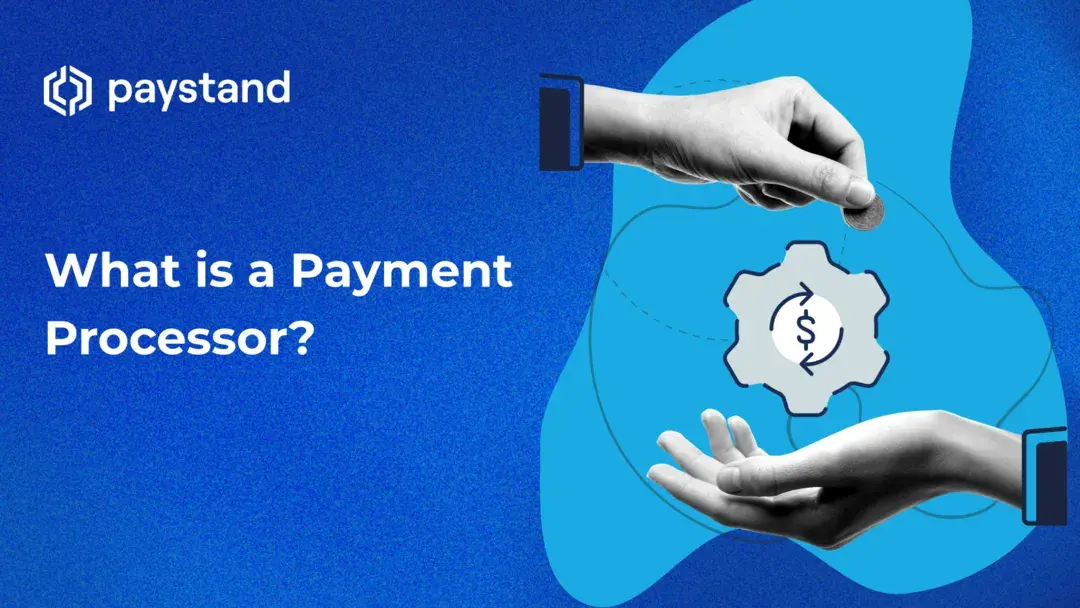Payment Processors: How They Work & Why You Need One

Table of Contents
- What is a Payment Processor?
- Why Are Payment Processors Important, and Why Does Your Business Need One?
- How Does a Payment Processor Work?
- Payment Processor vs. Payment Gateway and Payment Facilitators
- Payment Processor Examples
- Tips for Effectively Selecting Your Payment Processor
Key Takeaways
- What is a Payment Processor? A service that allows businesses to accept credit and debit card payments by managing the transaction process between merchants and banks.
- How it Works: Payment processors verify and authorize transactions, transferring funds securely and quickly between payers and payees.
- Why it Matters: Payment processors simplify the acceptance of card payments, helping businesses meet modern customer expectations.
- Key Differences: Payment processors work with payment gateways and facilitators, each serving a distinct function in the payment process.
- Examples: Solutions like Paystand, Stripe, and Square provide payment processing, with Paystand standing out in B2B zero-fee payments and A/R automation.
- Choosing a Payment Processor: Consider factors like cost, payment methods, software integrations, and the overall impact on your cash cycle.
What is a Payment Processor?
A payment processor or merchant processor is a vendor service that allows business owners (often called merchants in the payment process) to accept digital payments. This is mainly because payment processors are designed to manage the logistics of credit and debit card transactions for businesses, so they don’t have to worry about certain complexities involved in this process.
Typically, to be able to process credit card transactions, your business will need a merchant account. Still, to get one, your company must meet various requirements, including having a business license, making an agreement where your business submits to underwriting, and undergoing a stringent approval process. This process can take quite a bit of time, and if your business is too new or doesn't fit all of the requirements, it may not be accepted.
Payment processors eliminate the need for businesses to go through the headache of securing their merchant accounts. Instead, they manage the credit card transaction process as the bank and merchant middleman. Payment processors authorize payments for your business by verifying customers’ billing information, confirming that your customer’s funds are available in their accounts, and transferring the money to your bank account. This entire process occurs in a matter of seconds and is used for both card-present and card-not-present transactions.
Why Are Payment Processors Important, and Why Does Your Business Need One?
Payment processors are important because, without one, it can be complicated to accept credit and debit card payments from your customers both online and offline – something that’s essential if businesses want to keep up with the current landscape of consumer behavior.
How Does a Payment Processor Work?
A payment processor works – usually completely unnoticed – in the background to ensure payments go from your customer’s bank account to your business’s. While end customers don’t have visibility into the whole process, a lot goes on to ensure that the funds are moved securely and efficiently from payer to payee. Here’s what that process looks like in more detail:
- Firstly, a customer must give their card information to the merchant (your business). This can be in either card-present (via a payment terminal in-store) or card-not-present scenarios (via cloud software online).
- Secondly, the customer’s payment information is sent to a payment gateway, which securely sends the transaction data to the payment processor.
- Next, a card network (such as Visa or Mastercard) will let the payment processor know whether the payment has been approved. Once the payment is approved, the processor will contact the bank that issued the customer’s card to finalize the transaction and officially facilitate the funds transfer.
- Then, the card network transfers the funds to the merchant’s (acquiring) bank.
- The acquiring bank finally deposits the funds into the merchant’s account, completing the transaction.
Payment Processor vs. Payment Gateway and Payment Facilitators
Sometimes, it can be easy to confuse payment processors, payment gateways, and payment facilitators. But each has its distinct place in the payment cycle and separate functionality.
Here is a table to help explain their different roles:
| Category | Function | Role | Example Use Cases |
|---|---|---|---|
| Payment Processor | Handles fund transfers and settlement. | Connects merchant and customer banks. | Credit card and ACH transactions. |
| Payment Gateway | Secures and transmits payment data. | Entry point for processing transactions. | Online checkouts and POS systems. |
| Payment Facilitator | Enables sub-merchants to accept payments. | Manages shared merchant accounts. | Platforms for small businesses or gigs. |
Payment Gateways
Similarly to how payment processors are the middlemen between banks and merchants, payment gateways are the middlemen between payment processors – and in some cases, merchant accounts – and credit or debit card companies. Payment gateways connect your customers’ financial accounts to your merchant account.
A payment gateway is the gatekeeper of your customers’ payment data. It’s a mechanism that reads and transfers payment information from your customer’s bank accounts to your business’s bank account by capturing the necessary payment information and ensuring that the funds for the desired transfer are readily available in your customers’ bank accounts. Without payment gateways, you could not charge a purchase amount to your customers’ credit cards.
Payment gateways can be used both in-store and online. In-store payment gateways use software built into a physical point-of-sale (POS) system, while online payment gateways use cloud-based software to link payers and payees.
Payment Facilitators
A payment facilitator is an element of essential payment infrastructure that makes it possible for sub-merchants to accept credit card payments. A sub-merchant is similar to a merchant. It acts as the payment facilitator’s customer and uses the payment facilitator to accept online payments from its customers. Payment facilitators must underwrite and onboard sub-merchants and give them the tools to process online payments.
Businesses partner with payment facilitators because they help create a more streamlined customer payment experience while optimizing critical AR processes.
Payment Processors
Remember, a payment processor mediates between your business and the financial institutions necessary to accept your customers' credit and debit card transactions. Payment processors use payment gateways to authorize whether or not your customers have enough funds in their accounts to make the transaction they want to make and to transfer the funds from your customer’s bank account to your business’s bank account.
Payment Processor Examples
Paystand – A B2B payment processor that eliminates transaction fees, automates accounts receivable and leverages a unique B2B Network to improve cash flow and profitability.
Stripe – A developer-friendly payment processor for online businesses, supporting credit cards, ACH, and digital wallets.
Square – Known for its easy-to-use POS systems and credit card processing for small businesses.
PayPal – A widely recognized solution for online payments, invoicing, and digital wallets.
Adyen – A global payment processor that supports multiple payment methods across regions.
Paystand differentiates itself by focusing on zero-fee B2B payments, automating the entire A/R process, and providing tools to shift payer behavior to more profitable payment methods, which traditional processors often don’t address.
Tips for Effectively Selecting Your Payment Processor
Selecting the right payment processor for your business is critical – who you choose to partner with as a provider will significantly impact your cash cycle. You’ll want to make sure you’re picking a payment processor that offers everything your business needs, and there are several different elements that you should consider as you search for the most appropriate partner:
- Features and abilities. Make sure that your processor can handle many different payment methods, or at least the ones that have historically been used in your payment process. Some of the most common payment methods are credit cards, electronic bank transfers via ACH payment, and wire transfers. Your AR department will easily manage payments if your payment processor can exclusively handle all standard payment methods.
- Cost. Fees are everywhere regarding payment processor services, and extra costs are essential for your finance team to consider. Here are the most common payment processor fees to look out for:
- Transaction fees
- Annual start-up fees
- Monthly statement fees
- Chargeback fees
- Minimum monthly fees
- When considering which payment processor to work with, it’s essential to look at the entire cost of a processing service. Instead of looking at each fee individually, you’ll need to figure out how much your business would cost to operate with a particular payment processor monthly.
- The typical pricing structures of payment processors include interchange-plus, flat-rate, and tiered pricing. Each option has pros and cons, so when comparing services, you’ll have to look at the overall monthly cost to evaluate the best payment processor for your business.
When considering software integrations
Finally, when deciding which payment processor to partner with, you’ll want to choose an option that easily integrates with your existing accounting software. If your preferred payment processor can be incorporated into your ERP system, you’ll save your accounting team countless hours that would otherwise have to be spent manually entering data. That means your finance organization can instead spend its time where it matters: engaging in strategic planning and working to drive more revenue.




%20(1)%20(1).jpg?width=100&height=100&name=IMG_3752%20(1)%20(1)%20(1).jpg)